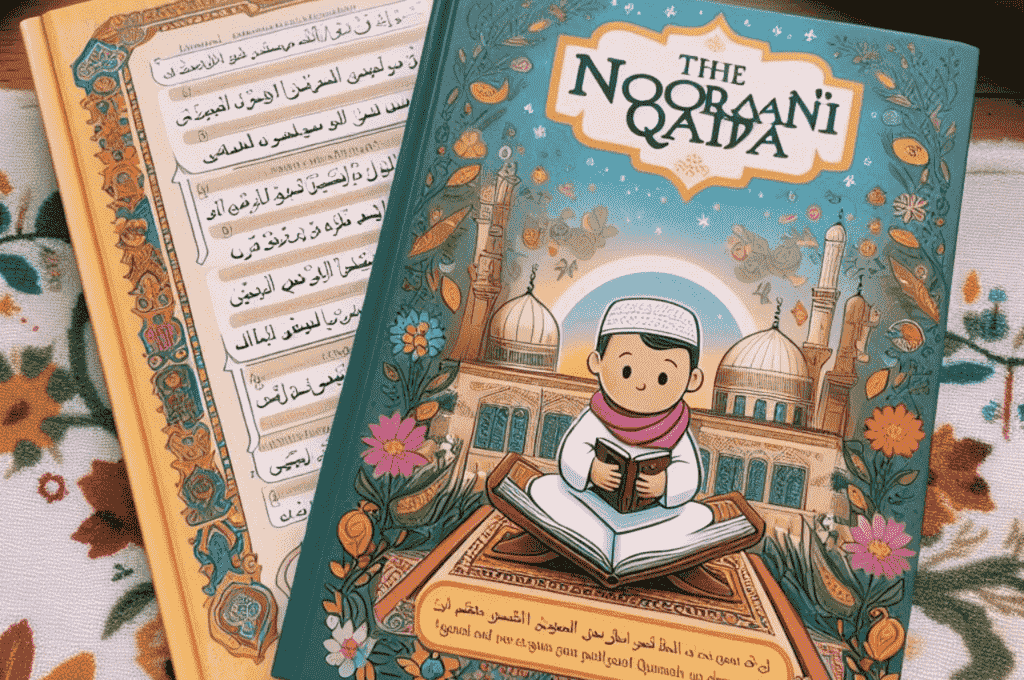Here is a rewritten and polished version of your full content for improved clarity, flow, and readability while preserving all the important details:
Noorani Qaida & Tajweed-ul-Quran: A Comprehensive Guide to Learning Quranic Basics
Introduction
Noorani Qaida is a foundational book created to help beginners learn the Arabic alphabet, proper pronunciation, and the basic rules of Tajweed (Quranic phonetics). It is widely used around the world by children and adults beginning their journey in Quranic recitation. This guide offers a detailed overview of Noorani Qaida—its structure, advantages, and effective study tips—alongside an introduction to the importance of Tajweed.
What is Noorani Qaida?
Noorani Qaida is a step-by-step booklet that introduces learners to the Arabic language and proper pronunciation of letters and words. It forms the essential groundwork for anyone seeking to recite the Quran fluently and in accordance with Tajweed rules.
Structure of Noorani Qaida
Noorani Qaida is carefully divided into progressive lessons, each focusing on a different aspect of reading Arabic. Key components include:
- Arabic Alphabet – Introduction to individual letters
- Harakat (Short Vowels) – Learning Fatha, Kasra, and Damma
- Tanween (Double Vowels) – Understanding the pronunciation of double vowels
- Madd (Prolongation) – Rules for elongating vowel sounds
- Sukoon and Jazm – Identifying silent letters and their effect on pronunciation
- Tajweed Basics – Foundational rules to improve Quranic recitation
- Practical Exercises – Joining letters and words to build fluency
Benefits of Learning Noorani Qaida
- Solid Foundation for Quranic Reading
Noorani Qaida provides the first and most crucial step toward reading the Quran with accuracy and fluency. - Introduction to Tajweed
Learners are introduced to essential Tajweed concepts early, encouraging correct and beautiful recitation. - Structured, Easy-to-Follow Approach
Lessons are arranged in a gradual, step-by-step manner, making learning simple and effective. - Suitable for All Ages
Whether for children or adults, Noorani Qaida is accessible and beneficial for learners at any stage. - Flexible, Self-Paced Learning
Students can study independently and progress at their own pace, allowing for convenience and flexibility.
How to Learn Noorani Qaida Effectively
- Consistent Practice
Daily repetition is key to mastering pronunciation and rules. - Learn with a Qualified Tutor
A knowledgeable teacher can correct mistakes and accelerate learning. - Use Digital Tools and Online Resources
Many websites and apps now offer interactive lessons and guided courses. - Read Aloud
Reciting aloud helps improve clarity and builds confidence in pronunciation. - Review Past Lessons Frequently
Regular revision ensures better retention and fluency over time.
Online Learning Options for Noorani Qaida
Thanks to modern technology, learning Noorani Qaida has become more accessible than ever. Online platforms now offer:
- Video Tutorials
- Live Sessions with Tutors
- Interactive Exercises and Practice Tests
- Self-paced Modules for Independent Learning
Tajweed-ul-Quran: Perfecting Quranic Recitation
What is Tajweed-ul-Quran?
Tajweed refers to the set of rules that govern the correct pronunciation and articulation of Quranic verses. It ensures that each letter is pronounced accurately and that recitation follows the style passed down from Prophet Muhammad (PBUH).
Why Tajweed Matters
- Preserves the Original Revelation
Tajweed safeguards the authentic way the Quran was revealed. - Deepens Spiritual Connection
Correct recitation fosters a more profound engagement with the Quran’s meanings. - Prevents Misinterpretation
Proper pronunciation prevents unintentional changes in meaning. - Mandated in the Quran
Surah Al-Muzzammil (73:4) instructs believers to “recite the Quran in a measured tone” (tarteel), emphasizing the importance of Tajweed.
Key Tajweed Rules
- Makharij (Articulation Points) – Learning where and how each letter is pronounced
- Sifaat (Characteristics) – Understanding unique letter attributes (e.g., heaviness, softness)
- Ghunnah (Nasalization) – Using nasal sounds correctly for letters like Meem and Noon
- Idgham (Merging Letters) – Combining similar sounds to improve fluency
- Qalqalah (Echoing Sound) – Applying a slight vibration to certain letters in sukoon
- Madd (Prolongation) – Knowing when and how to stretch vowel sounds properly
How to Learn Tajweed Effectively
- Study Under a Qualified Teacher
Personalized feedback from an expert is essential for proper articulation. - Practice Consistently
Repeating verses with correct pronunciation builds long-term skill. - Listen to Professional Qaris
Emulating the recitation styles of skilled Quran readers improves fluency and intonation. - Join Tajweed Courses
Both online and in-person classes offer structured Tajweed instruction. - Use Tajweed Apps and Learning Tools
Mobile apps now offer detailed lessons, quizzes, and real-time feedback.
Conclusion
Noorani Qaida and Tajweed-ul-Quran are essential tools for anyone beginning their journey in Quranic learning. While Noorani Qaida builds the foundation of Arabic reading and pronunciation, Tajweed polishes and perfects recitation. With dedication, consistent practice, and the right guidance—whether through tutors, apps, or online classes—learners can develop fluency, accuracy, and a deeper spiritual connection to the Quran.







